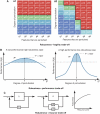Robustness trade-offs. (
A) If robustness is strictly conserved, then any increase in robustness for specific perturbation shall be compensated by increase in fragility elsewhere. Left panel is a profile of robustness of a hypothetical system that responds equally to perturbations of each feature (from g1 to g6). Now, if the system is tuned to cope better with perturbations of a subset of features (g1, g2, and g3), then robustness against other subset of perturbations are significantly reduced (right panel). Total robustness of both systems over this perturbation space remains equal. (
B) If the robustness-performance trade-off holds, a system that is tuned to attain high performance might be less robust than a system with moderate performance but a higher level of robustness. Let's assume
Ya=
fa(0) for system A where
f(0) is the performance of the function of the system under perturbation ‘0' (no perturbation) and
Ra is the robustness of the system over some defined perturbations. Although the figure simply refers to the colored areas for ease of understanding, the exact
Ra needs to be calibrated based on Equation (1). The horizontal dashed lines indicate the threshold under which the system fails to perform the function considered. A robustness-performance trade-off would then imply that
YaRa=
YbRb. (
C) Identical circuits with slightly difference resource use are shown. Both use NFB loop, but one uses only one resistor in the loop, whereas the other one uses two resistors in parallel. Parallel use of components significantly improves robustness of the system against component failure, but requires more resources. Here, the probability of degradation of system function can be computed using basic equations from reliability engineering so that the difference of robustness can be derived for simple example like this one. It is however challenging to derive an expression for more complex systems under various perturbations. The question is how can we compute

where
mS1 and
mS2 are resource used for system S1 and S2, respectively. The function U would relate the difference of resource use to the difference in robustness as a function of some design principles according to which resources are used. Whether it is at all possible to define such a function and, more fundamentally, whether such conservation actually exists, in either relative or strict manner, remains open.




 where mS1 and mS2 are resource used for system S1 and S2, respectively. The function U would relate the difference of resource use to the difference in robustness as a function of some design principles according to which resources are used. Whether it is at all possible to define such a function and, more fundamentally, whether such conservation actually exists, in either relative or strict manner, remains open.
where mS1 and mS2 are resource used for system S1 and S2, respectively. The function U would relate the difference of resource use to the difference in robustness as a function of some design principles according to which resources are used. Whether it is at all possible to define such a function and, more fundamentally, whether such conservation actually exists, in either relative or strict manner, remains open.
